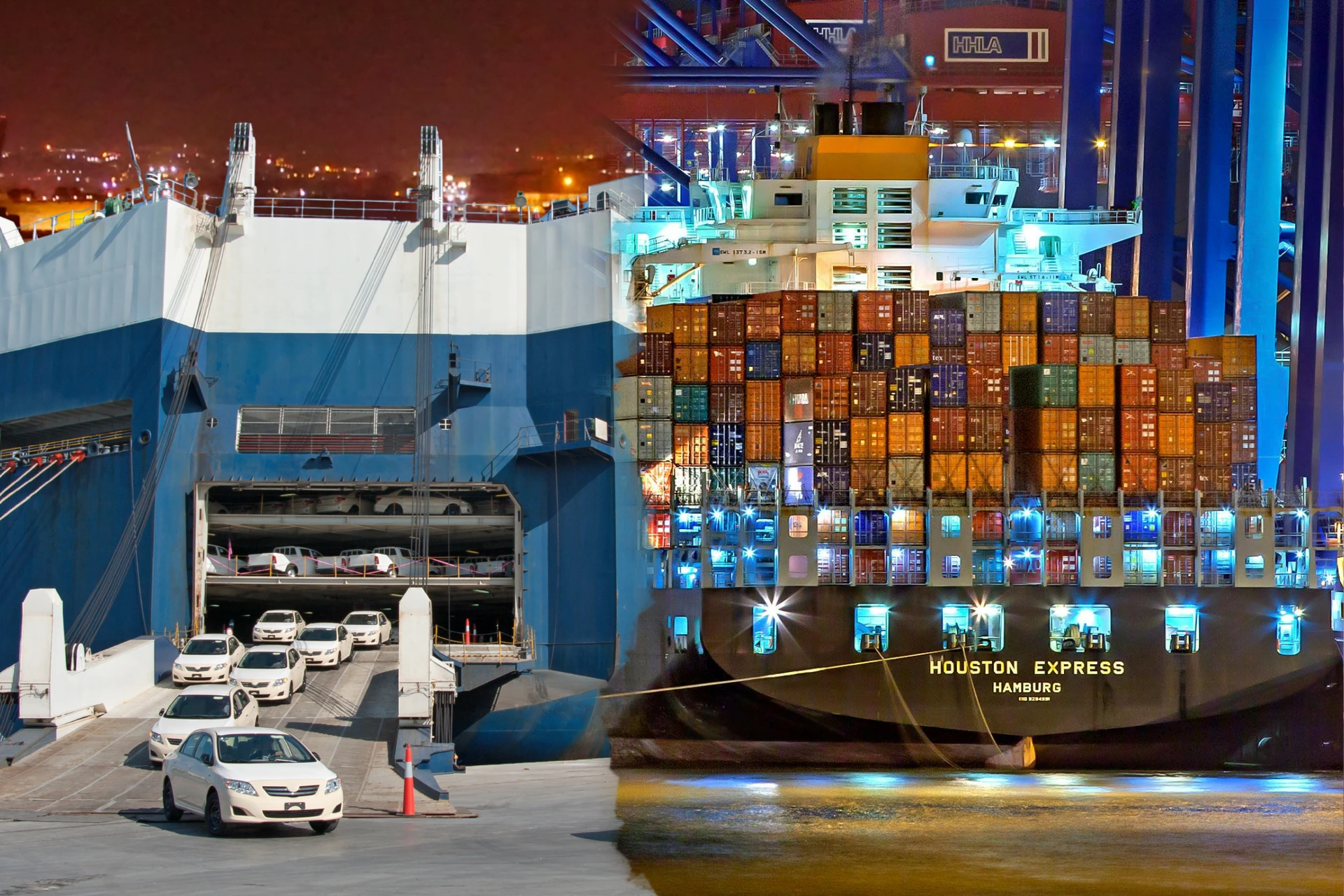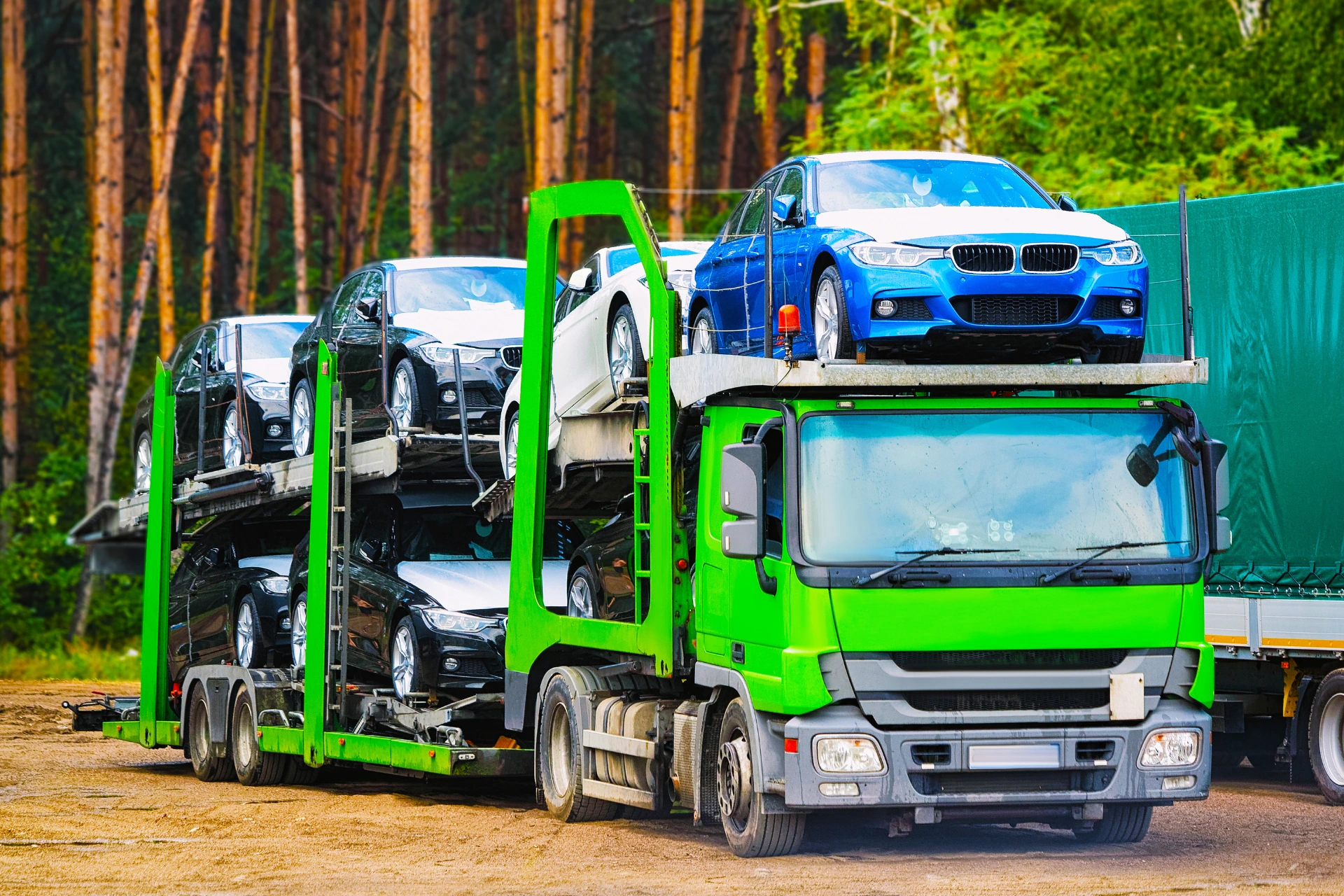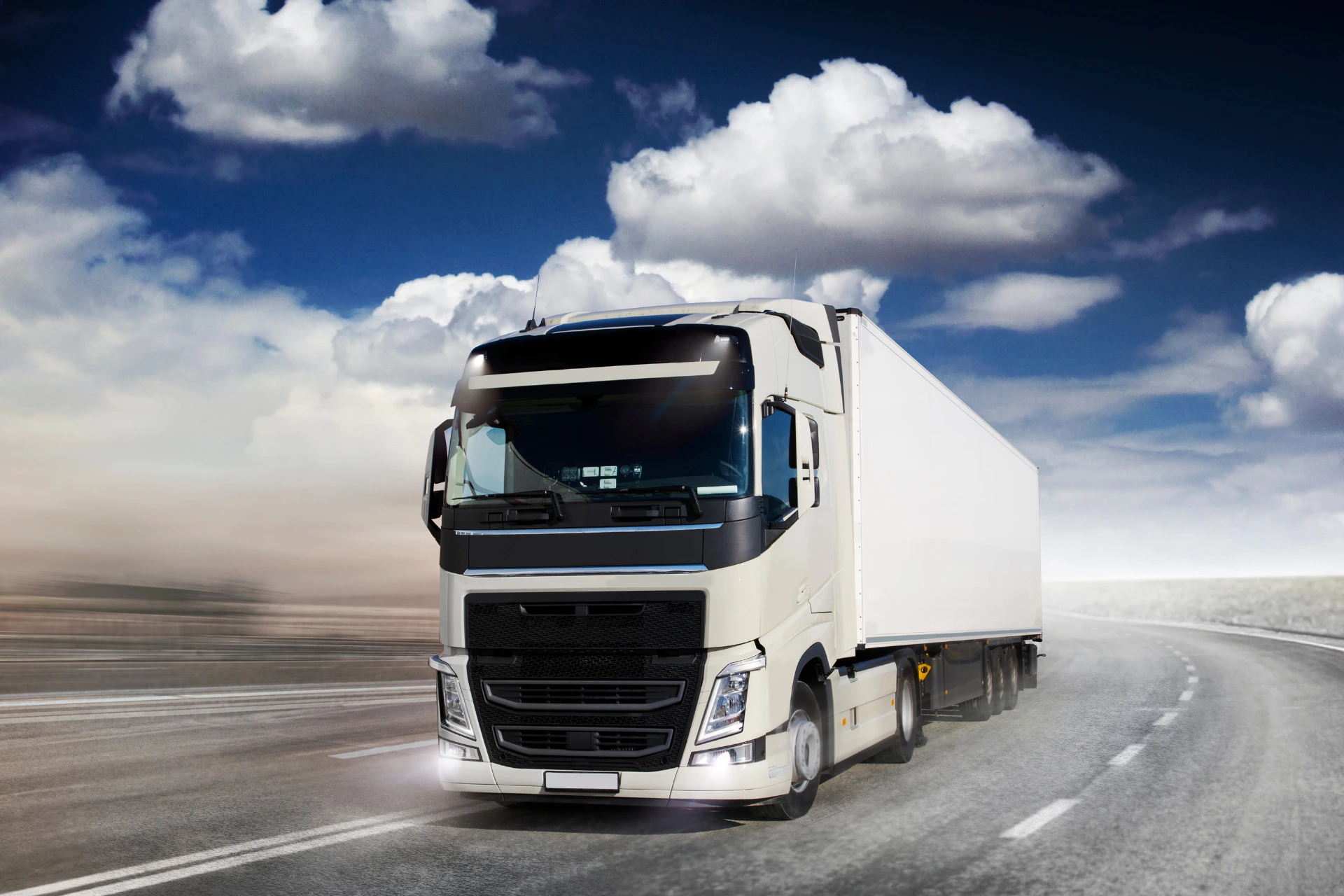
Ro-Ro vs. Container Shipping: Which Method is Best for Your Cargo?
Navigating the world of international car shipping methods can be daunting, especially when choosing between Ro-Ro shipping and container shipping for your cargo. Whether relocating a classic car, transporting a fleet via auto transport Ro-Ro, or shipping heavy machinery with container car shipping, selecting the right vehicle shipping methods is crucial for cost, vehicle shipping safety, and efficiency.
Ro-Ro (roll-on roll-off) shipping offers a streamlined, cost-effective solution for drivable vehicles, with efficient vehicle loading for Ro-Ro shipping, while container shipping provides enclosed container transport for enhanced protection and flexibility for diverse cargo types. Each cargo shipping option has unique pros and cons, but the best choice depends on your vehicle, budget, and destination.
This guide breaks down how to choose shipping methods for cargo, offering insights on cost comparison Ro-Ro vs container shipping, advantages of container shipping, and more, with real-world examples.
At Transportvibe, we believe choosing a transport company for Ro-Ro vs container shipping should be simple, transparent, and informed. Our platform empowers you with honest, unbiased reviews of providers, ensuring reliable partners for sea freight vehicle shipping.
Table Of Contents
- What is Ro-Ro Shipping?
- Key Features of Ro-Ro Shipping
- What is Container Shipping?
- Key Features of Container Shipping
- Ro-Ro vs. Container Shipping: Key Differences
- Key Differences
- Pros and Cons of Ro-Ro Shipping
- Advantages of Ro-Ro Shipping
- Disadvantages of Ro-Ro Shipping
- Pros and Cons of Container Shipping
- Advantages of Container Shipping
- Disadvantages of Container Shipping
- Cost Comparison: Ro-Ro vs Container Shipping
- Cost Breakdown and Factors
- Safety and Security Considerations
- Key Safety and Security Factors
- Which Method is Best for Your Cargo?
- Scenarios for Choosing Ro-Ro Shipping
- Scenarios for Choosing Container Shipping
- Environmental and Logistical Considerations
- Key Considerations
- FAQ’s On Ro-Ro vs Container Shipping
- Making the Final Call for Your Cargo
What is Ro-Ro Shipping?
Ro-Ro, or roll-on roll-off shipping, is a specialized method for Ro-Ro shipping for cars, trucks, and heavy machinery on dedicated vessels. It’s designed for efficiency, allowing vehicle loading for Ro-Ro shipping directly onto and off the ship.
Ro-Ro vessels feature multiple decks with ramps, enabling quick auto transport Ro-Ro. This method is popular for high-volume vehicle shipping methods due to its speed and cost-effectiveness, and it’s particularly important to understand when you’re shipping an electric vehicle. For a deeper dive, read our Ultimate Guide to Shipping Electric Vehicles in 2025.
Key Features of Ro-Ro Shipping
- Definition and Process: Ro-Ro ships, built for roll-on roll-off shipping, have open decks shipping and ramps, allowing vehicles to roll on/off without cranes. This minimizes handling, reducing loading time for auto transport Ro-Ro.
- Types of Cargo: Ideal for drivable vehicles like sedans, SUVs, trucks, buses, and construction equipment in Ro-Ro shipping for cars. Non-wheeled or non-running vehicles are typically unsuitable.
- Loading and Securing: Vehicles are driven onto ships via ramps for vehicle loading for Ro-Ro shipping and secured with lashings or wheel chocks. This prevents movement during transit, ensuring vehicle shipping safety.
- Vessel Design: Ro-Ro ships have adjustable decks to accommodate various vehicle sizes, from motorcycles to oversized machinery. Watertight compartments enhance safety for roll-on roll-off shipping.
- Efficiency: Loading/unloading takes hours, not days, making Ro-Ro faster than container shipping for sea freight vehicle shipping. This suits time-sensitive shipments on major routes.
- Cost-Effectiveness: Lower handling reduces costs, with prices for Ro-Ro shipping for cars ranging from $700–$3,500, depending on distance and vehicle size. This makes it a top cargo shipping option.
- Limitations: Vehicles face weather exposure on open decks, risking minor cosmetic damage, impacting vehicle shipping safety. Limited port availability restricts destinations for auto transport Ro-Ro.
Ro-Ro shipping suits businesses and individuals using international car shipping methods for functional vehicles on major trade routes. However, its pros and cons of Ro-Ro shipping show it’s less secure than container shipping for high-value cargo.
What is Container Shipping?
Container shipping involves container car shipping and cargo in standardized metal containers loaded onto cargo ships. It’s a versatile method offering enclosed container transport for vehicle shipping safety and flexibility.
Containers, typically 20ft or 40ft, are loaded at ports using cranes for sea freight vehicle shipping globally. This method suits vehicles, personal belongings, and mixed cargo, ideal for international car shipping methods.
Key Features of Container Shipping
- Definition and Process: Vehicles are driven or loaded into containers for container shipping for vehicles, sealed, and hoisted onto ships using cranes. Containers are then transported to destination ports.
- Types of Containers: Options include 20ft (one car), 40ft (two cars), or high-cube for taller vehicles in enclosed container transport. Full Container Load (FCL) or Less than Container Load (LCL) options suit different cargo shipping options.
- Loading and Securing: Vehicles are driven or forklifted into containers and secured with straps for container car shipping. Additional cargo, like personal items, can be packed alongside.
- Security Benefits: Enclosed container transport protects vehicles from weather, theft, and damage, ensuring vehicle shipping safety. Containers are sealed at origin, reducing tampering risks.
- Versatility: Container shipping for vehicles suits non-running vehicles, luxury cars, or oversized cargo unfit for Ro-Ro. It allows mixed shipments, combining vehicles with household goods.
- Global Reach: Container ships access more ports than Ro-Ro, offering flexibility for sea freight vehicle shipping. This is ideal for remote routes in international car shipping methods.
- Drawbacks: Loading/unloading is slower for container shipping, increasing transit time. Costs for container car shipping range from $900–$5,000, depending on type and distance.
- Advantages: The advantages of container shipping include superior protection and versatility for complex logistics. It’s perfect for high-value vehicles needing cargo shipping insurance.
Container shipping excels for secure, flexible transport, especially for luxury or non-running vehicles. Despite higher costs, the advantages of container shipping make it a top choice for complex cargo shipping options.
Explore top auto shipping companies in the USA. Read genuine customer reviews to choose a reliable provider for your cargo!
Ro-Ro vs. Container Shipping: Key Differences
Ro-Ro vs container shipping serves distinct needs in vehicle shipping methods, differing in process, cost, and suitability. Understanding these helps you decide how to choose shipping methods for cargo.
Ro-Ro shipping for cars involves driving vehicles onto specialized ships, while container car shipping secures vehicles in metal containers loaded via cranes. Each offers unique benefits for international car shipping methods.
Key Differences
- Loading/Unloading Process: Ro-Ro allows vehicle loading for Ro-Ro shipping via ramps, enabling fast auto transport Ro-Ro in hours. Container shipping for vehicles uses cranes, taking days.
- Cargo Types: Auto transport Ro-Ro suits drivable vehicles like cars, trucks, and machinery. Container shipping for vehicles accommodates non-running vehicles, luxury cars, and personal items.
- Protection Level: Ro-Ro shipping for cars risks minor weather damage on open decks. Enclosed container transport ensures vehicle shipping safety against weather, theft, and handling.
- Cost Factors: Roll-on roll-off shipping costs $700–$3,500 due to minimal handling in cost comparison Ro-Ro vs container shipping. Container car shipping ranges from $900–$5,000, especially for FCL.
- Port Availability: Ro-Ro shipping operates on limited routes for sea freight vehicle shipping. Container shipping reaches more global ports, offering destination flexibility.
- Speed: Auto transport Ro-Ro ensures faster transit for major routes. Container shipping for vehicles may face delays due to complex handling.
| Aspect | Ro-Ro Shipping | Container Shipping |
| Loading | Vehicle loading for Ro-Ro shipping via ramps | Enclosed container transport via cranes |
| Cargo Suitability | Drivable vehicles for auto transport Ro-Ro | Non-running vehicles, mixed cargo |
| Protection | Exposed, risks to vehicle shipping safety | Enclosed, high vehicle shipping safety |
| Cost | $700–$3,500 (cost comparison Ro-Ro vs container shipping) | $900–$5,000 |
| Port Access | Limited for sea freight vehicle shipping | Wider global reach |
| Speed | Faster for major routes | Slower due to handling |
Pros and Cons of Ro-Ro Shipping
Ro-Ro (roll-on/roll-off) shipping is a popular method for transporting drivable vehicles across oceans. Its efficiency and cost-effectiveness make it appealing, but limitations must be considered.
Understanding the advantages and disadvantages of Ro-Ro shipping helps you decide if it suits your cargo. Below, we break down its key benefits and drawbacks in detail.
Advantages of Ro-Ro Shipping
- Cost-Effectiveness: Ro-Ro shipping typically costs $700–$3,500, cheaper than container shipping due to minimal handling. It’s ideal for budget-conscious shippers moving functional vehicles.
- Fast Loading/Unloading: Vehicles are driven onto ships via ramps, completing the process in hours. This efficiency reduces port time and speeds up delivery.
- High-Volume Capability: Ro-Ro vessels can carry hundreds of vehicles, from cars to heavy machinery. This makes it perfect for manufacturers or dealers shipping large fleets.
- Suitability for Large Vehicles: Oversized vehicles like trucks, buses, or construction equipment fit easily on adjustable Ro-Ro decks. These vessels accommodate vehicles too large for standard containers.
- Simplified Logistics: The roll-on/roll-off process requires less coordination than container shipping. It’s a straightforward option for major trade routes with frequent Ro-Ro services.
Disadvantages of Ro-Ro Shipping
- Limited Protection: Vehicles on open or partially covered decks are exposed to weather, risking minor cosmetic damage like scratches or saltwater corrosion. Sensitive or luxury cars may need extra care.
- Restricted Cargo Types: Ro-Ro is limited to drivable, wheeled vehicles, excluding non-running cars or non-vehicular cargo. Additional items like personal belongings are typically not allowed.
- Limited Port Availability: Ro-Ro ships operate on specific routes, servicing fewer ports than container ships. This can restrict destination options for less common routes.
- Potential for Handling Damage: Despite secure lashings, vehicles may experience minor bumps during loading or transit. This risk is higher than with enclosed containers.
- Biosecurity Challenges: Open decks increase exposure to pests or contaminants, requiring strict cleaning to meet biosecurity regulations. This can add preparation time and costs.
Ro-Ro shipping excels for cost-effective, high-volume transport of drivable vehicles on major routes. However, its exposure risks and cargo limitations may make container shipping a better choice for some.
Pros and Cons of Container Shipping
Container shipping transports vehicles and cargo in standardized metal containers, offering security and versatility. It’s ideal for diverse needs but comes with higher costs and logistical complexities.
Understanding the strengths and weaknesses of container shipping helps determine if it’s the right choice for your cargo. Below, we detail its key advantages and disadvantages comprehensively.
Advantages of Container Shipping
- Enhanced Protection: Enclosed containers shield vehicles from weather, theft, and handling damage during transit. This makes it ideal for luxury or classic cars requiring maximum safety.
- Versatility for Cargo: Containers accommodate non-running vehicles, oversized cargo, and personal belongings alongside vehicles. Full Container Load (FCL) or Less than Container Load (LCL) options add flexibility.
- Global Port Access: Container ships service a vast network of ports worldwide, unlike Ro-Ro’s limited routes. This ensures greater destination flexibility for remote or less-trafficked locations.
- Secure Transport: Containers are sealed at the origin, reducing tampering risks. This provides peace of mind for high-value or sensitive shipments.
- Customizable Options: Containers come in various sizes (20ft, 40ft, high-cube), allowing tailored solutions for single vehicles or mixed cargo. This adaptability suits complex shipping needs.
Disadvantages of Container Shipping
- Higher Costs: Container shipping ranges from $900–$5,000, more expensive than Ro-Ro due to crane handling and container fees. Exclusive FCL containers significantly increase costs.
- Slower Loading/Unloading: Loading vehicles into containers and using cranes for ship transfer takes longer than Ro-Ro’s roll-on process. This can delay transit times by days.
- Space Limitations: Standard containers may not accommodate oversized vehicles like large trucks or machinery. High-cube containers are needed, raising costs further.
- Complex Logistics: Coordinating container packing, sealing, and intermodal transfers (e.g., ship to truck) requires more planning. This can complicate timelines and increase oversight needs.
- Potential for Internal Damage: Improper securing inside containers can lead to vehicle movement or damage during transit. Professional loading is critical to avoid issues.
Container shipping is perfect for secure, flexible transport of diverse cargo, especially for high-value or non-running vehicles. However, its higher costs and slower process may deter budget-conscious shippers.
Cost Comparison: Ro-Ro vs Container Shipping
Cost is a critical factor when choosing between Ro-Ro and container shipping for your vehicle. Understanding the pricing differences and influencing factors helps you make an informed decision.
Ro-Ro shipping is generally more affordable, with costs ranging from $700 to $3,500, depending on various factors. Container shipping, while offering greater protection, typically costs between $900 and $5,000.
Cost Breakdown and Factors
- Ro-Ro Cost Range: Ro-Ro shipping averages $700–$3,500, driven by lower handling fees and efficient loading. For example, shipping a sedan from the US to Europe may cost $1,200–$2,000.
- Container Cost Range: Container shipping costs $900–$5,000, with Full Container Load (FCL) being pricier than Less than Container Load (LCL). A 20ft container for one car to Europe might cost $2,500–$4,000.
- Distance and Route: Longer distances increase costs for both methods, but Ro-Ro benefits from fixed routes, reducing variability. Container shipping costs rise with remote destinations due to port handling.
- Vehicle Size and Type: Larger vehicles like trucks raise Ro-Ro costs due to deck space, while containers have fixed sizes, limiting oversized cargo. High-cube containers for tall vehicles add expense.
- Shared vs. Exclusive Use: Ro-Ro inherently shares vessel space, keeping costs low. Container shipping offers FCL for exclusive use (higher cost) or LCL for shared space (cheaper but riskier).
- Additional Fees: Ro-Ro may incur cleaning fees for biosecurity compliance, while container shipping includes crane and terminal handling charges. Both methods may involve customs or insurance fees.
- Example Breakdown: Shipping a sedan from New York to Rotterdam via Ro-Ro costs ~$1,500, including port fees. The same via a 20ft FCL container costs ~$3,000, including handling and sealing.
Ro-Ro is budget-friendly for drivable vehicles, while container shipping suits high-value cargo shipping options despite higher costs.
Save on shipping costs! Visit Transportvibe to compare Ro-Ro and container transport providers and find the best rates.
Safety and Security Considerations
Safety and security are critical when choosing between Ro-Ro and container shipping. Each method offers distinct protections for vehicle shipping safety and cargo security.
Ro-Ro vehicles face exposure to elements on open decks, risking minor scratches or corrosion. Lashings secure vehicles, but handling may cause slight damage during loading.
Container shipping provides enclosed protection, shielding vehicles from weather, theft, and vandalism. Sealed containers ensure cargo safety, ideal for high-value or delicate vehicles.
Cargo shipping insurance is essential for both methods to cover potential damage or loss. Policies vary, so verify coverage for weather, handling, or transit-related risks.
For a comprehensive look at what’s covered, check out our guide – Does Your Car Insurance cover Auto Transport?
Key Safety and Security Factors
- Ro-Ro Exposure: Open decks leave vehicles vulnerable to saltwater or weather damage. Regular inspections minimize risks, but protection is limited compared to containers.
- Container Security: Enclosed containers reduce theft and environmental risks. Proper securing prevents internal movement, ensuring vehicle shipping methods safety.
- Handling Risks: Ro-Ro’s roll-on process may cause minor bumps during transit. Containers require careful loading to avoid damage from improper securing.
- Insurance Needs: Cargo shipping insurance protects against unforeseen issues in both methods. Confirm policies cover specific risks like corrosion or theft.
Ro-Ro suits budget-conscious shippers but offers less protection, while container shipping prioritizes safety for sensitive cargo. Choose based on your vehicle’s value and risk tolerance.
Which Method is Best for Your Cargo?
Choosing between Ro-Ro and container shipping depends on your vehicle, budget, destination, and priorities. This section helps you identify the best method by analyzing key decision factors.
Ro-Ro shipping excels for cost-effective transport of drivable vehicles, while container shipping offers superior protection and flexibility. Below, we outline scenarios and factors to guide your choice.
Scenarios for Choosing Ro-Ro Shipping
- Budget Constraints: Ro-Ro’s lower costs ($700–$3,500) make it ideal for cost-conscious shippers. It suits individuals or businesses moving standard vehicles like sedans or trucks.
- Drivable Vehicles: Ro-Ro requires vehicles to be operational for roll-on/roll-off. This method is perfect for functional cars, SUVs, or heavy machinery.
- Major Trade Routes: Ro-Ro vessels operate on high-traffic routes like US-Europe or Asia-Australia. These routes ensure frequent sailings and shorter transit times.
- High-Volume Shipments: Manufacturers or dealers benefit from Ro-Ro’s ability to handle large fleets efficiently. It minimizes per-vehicle costs for bulk transport.
Scenarios for Choosing Container Shipping
- Luxury or Classic Cars: Containers protect high-value vehicles from weather and handling damage. This is critical for expensive or delicate cars needing extra care.
- Non-Running Vehicles: Container shipping accommodates vehicles that can’t be driven, using forklifts or cranes. This flexibility suits project cars or damaged vehicles.
- Additional Cargo: Containers allow personal items or mixed cargo alongside vehicles, ideal for relocations. Full Container Load (FCL) offers exclusive space for such needs.
- Remote Destinations: Container ships access more ports globally, making them suitable for less common routes. This ensures delivery to remote or niche destinations.
Decision Factors
- Budget: Ro-Ro is cheaper but less secure; container car shipping costs more but offers protection. Assess your budget against the vehicle’s value.
- Vehicle Type: Drivable, standard vehicles favor Ro-Ro; non-running or oversized cargo suits containers. Consider your vehicle’s condition and size.
- Destination: Check port availability—Ro-Ro is limited, while containers reach more locations. Verify your route’s accessibility.
- Timeline: Ro-Ro is faster for major routes; containers may be delayed due to handling. Prioritize speed versus security based on needs.
Not sure which method to choose? Visit Transportvibe for all the available options and get reliable providers and reviews tailored to your shipping needs!
Environmental and Logistical Considerations
Environmental and logistical factors influence the choice between Ro-Ro and container shipping. Each method impacts sustainability and logistics differently for sea freight vehicle shipping.
Ro-Ro vessels use optimized designs, reducing fuel consumption and emissions. They’re efficient for high-volume transport on major routes but limited by port availability.
Container shipping supports intermodal transport, offering flexibility for complex routes. However, crane handling and transfers increase energy use and logistical complexity.
Port access and biosecurity regulations affect both methods. Ro-Ro’s limited routes may restrict options, while containers reach more destinations but require stricter compliance.
Key Considerations
- Environmental Impact: Ro-Ro shipping for cars often has lower emissions due to streamlined vessel designs. Container shipping for vehicles involves higher energy use from handling.
- Port Availability: Ro-Ro operates on specific routes, limiting destination options. Container ships access more ports, enhancing flexibility for sea freight vehicle shipping.
- Biosecurity Compliance: Ro-Ro’s open decks require thorough cleaning to meet regulations. Containers, being sealed, simplify biosecurity but demand precise documentation.
Ro-Ro is eco-friendly and logistically simple for major routes, while containers offer broader reach with complex logistics. Choose based on route and environmental priorities.
Choose eco-friendly shipping! Explore Transportvibe for reviews of sustainable Ro-Ro and container transport providers.
FAQ’s On Ro-Ro vs Container Shipping
What types of vehicles can be shipped via Ro-Ro?
Drivable vehicles like cars, trucks, and machinery; non-running or non-wheeled cargo requires container shipping.
Can personal belongings be shipped with Ro-Ro?
Typically, no; Ro-Ro restricts non-vehicle cargo, but containers allow personal items with vehicles.
How long does container shipping take compared to Ro-Ro?
Container shipping takes longer (1–2 weeks) due to crane handling; Ro-Ro is faster (days) on major routes.
What are the biosecurity requirements for vehicle shipping?
Vehicles must be cleaned to remove dirt and pests; Ro-Ro requires stricter checks due to open decks.
How do I choose between FCL and LCL container shipping?
FCL offers exclusive use for security; LCL shares space for cost savings, ideal for smaller shipments.
Is Ro-Ro or container shipping safer for luxury cars?
Container shipping is safer, offering enclosed protection against weather and theft for luxury vehicles.
What factors affect Ro-Ro and container shipping costs?
Distance, vehicle size, route, and container type (FCL/LCL) impact costs; Ro-Ro is generally cheaper.
Can non-running vehicles be shipped via Ro-Ro?
No, Ro-Ro requires drivable vehicles; container shipping handles non-running cars using forklifts or cranes.
Making the Final Call for Your Cargo
Choosing between Ro-Ro and container shipping ultimately depends on your specific needs. If you’re shipping a standard, drivable vehicle and prioritizing affordability and speed on a major route, Ro-Ro shipping is likely your best bet. However, for a high-value, non-running, or oversized vehicle—or if you need to ship personal belongings along with your car—the enhanced security and flexibility of container shipping make it the superior choice.
To make an informed decision and find the perfect transport provider for your unique cargo, explore honest reviews and compare options on Transportvibe.













